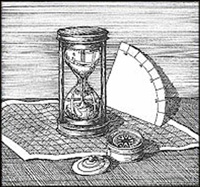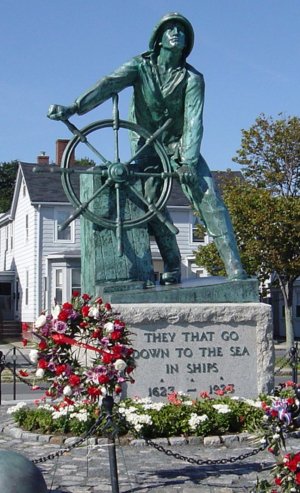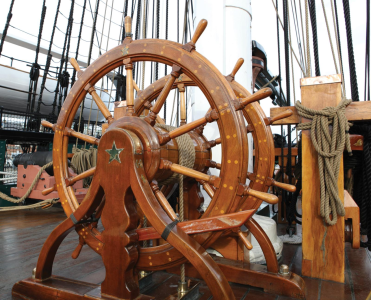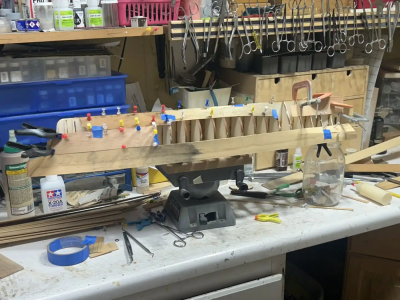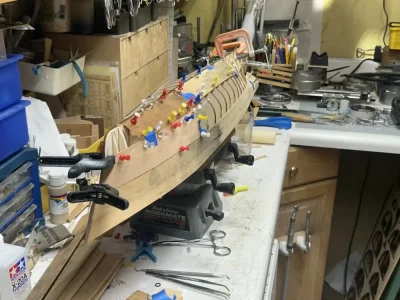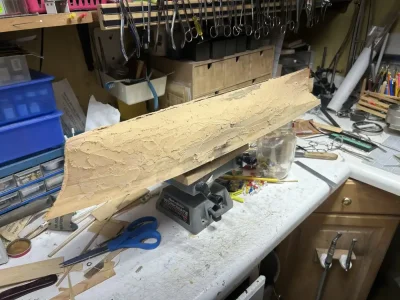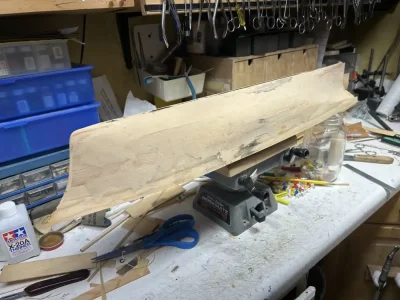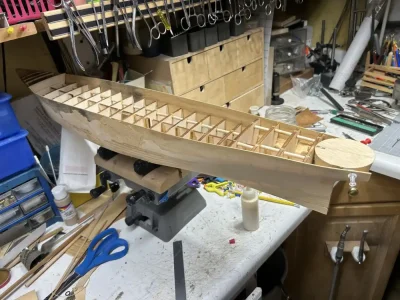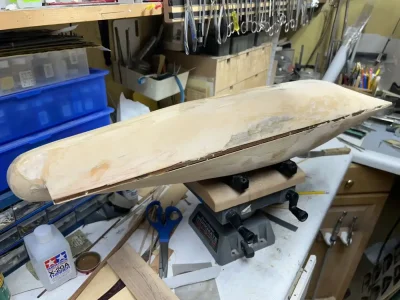And make it ring.Was
Rob,
Having a pencil next to that bell and mount drives home how tiny that is! Wow! You must have some fine magnifying lenses to fabricate that. I love this, it looks very authentic. Now if you can just engrave Stag Hound on it, that would just be awesome.... ;-)
-

Win a Free Custom Engraved Brass Coin!!!
As a way to introduce our brass coins to the community, we will raffle off a free coin during the month of August. Follow link ABOVE for instructions for entering.
-

PRE-ORDER SHIPS IN SCALE TODAY!
The beloved Ships in Scale Magazine is back and charting a new course for 2026!
Discover new skills, new techniques, and new inspirations in every issue.
NOTE THAT OUR FIRST ISSUE WILL BE JAN/FEB 2026
You are using an out of date browser. It may not display this or other websites correctly.
You should upgrade or use an alternative browser.
You should upgrade or use an alternative browser.
Staghound...Extreme clipper 1850 by rwiederrich 1/96
- Thread starter rwiederrich
- Start date
- Watchers 30
So if the helmsman stood in front of the wheel to steer, how did he know where he was going? His back would be to the bow.Finished the helm by adding the wheel.
Rob
View attachment 471819
View attachment 471820
View attachment 471821
A helmsman relies upon visual references, a magnetic compas, Cross-staff, Hourglass, Quadrant, Mariner's astrolabe, Kamal, and a rudder angle indicator to steer a steady course. some of the common tools are located in the binnacle, right in front of the helm.So if the helmsman stood in front of the wheel to steer, how did he know where he was going? His back would be to the bow.
Compass
The compass originated in China in the 3rd century, but didn't become common in Europe until the 15th century. 16th century compasses displayed a compass rose, which indicated 32 points of direction.
Cross-staff
A rectangular wooden staff with a scale and cross-pieces of different lengths. Sailors would use each cross-piece to measure latitude.
Hourglass
Sailors used sandglasses to measure time, which could range from 30 seconds to hours. They used solid materials instead of liquids, which would thicken with temperature changes.
Quadrant
A simple instrument that used a plumb bob to measure latitude by determining the angle between the sun or a star and the horizon.
Mariner's astrolabe
Developed in the late 15th century, this instrument was used in the 16th and 17th centuries. It was replaced by the back staff, octant, and sextant.
Kamal
Used the position of Polaris (the North Star) to determine latitude. Sailors would tie a knot in a cord, hold the knot between their teeth, and hold the wooden piece out vertically. They would then pull the cord taut to line it up with the North Star.
- Joined
- Jun 29, 2024
- Messages
- 1,443
- Points
- 393

The helmsman or in stormy weather helmsmen stood along side of the wheel facing forward. In addition to being able to see the compass he needed to be able to see the weather luff of the main topsail. If this began to luff then he was heading too high (too close to the wind) and needed to fall off (steer more away from the wind). While he was given a compass course to steer it was also his job to keep the sails full. Compass courses would have been given in “boxed directions”; the 32 directions obtained by boxing the compass ie, North, North by East, etc rather than exact numerical bearings that are used today so he had some leeway when steering the ordered course and still keeping the ships sails full.
Roger
Roger
- Joined
- Jun 19, 2013
- Messages
- 968
- Points
- 393

Indeed....and in most cases this took him off his true compass bearing....ultimately resulting in the need to tack. Rarely did the wind blow the direction you were headed.he needed to be able to see the weather luff of the main topsail. If this began to luff then he was heading too high (too close to the wind) and needed to fall off (steer more away from the wind).
Good description of the helmsman's navigational tooling.
Rob
- Joined
- May 21, 2023
- Messages
- 470
- Points
- 238

Norgale, beautiful photo. I've boarded Old Ironsides many times. Each time I find it's amazing how large this venerable 1800s Frigate really is. On a clipper ship, it would have been single, although Great Republic carried a double wheel like a ship of war due to her large size.This is most likely a small boat\ship's helm. On a three decker the helm is a, almost the same size as the helmsman.
Below is the helm of the Cony (HMS Constitution)
View attachment 484326
This double wheel shows that it was designed for two to four helmsmen at the same time. On the other hand, fishing boats like Gloucester Schooners wouldn't have needed such a large wheel. In fact, it would have been unmanageable. That's why it's so small on the Fisherman's Memorial. I shared it just to show the position of the helmsman to answer your question.
- Joined
- Jun 29, 2024
- Messages
- 1,443
- Points
- 393

For the last few nights I have been reading CSS Forester’s Captain From Connecticut about a fictional American Frigate during the War of 1812. At the moment the ship is trapped by the British and Forester provides an excellent account of the helmsman steering in shifting winds to keep the sails full while also struggling to maintain the ordered compass course.
Roger
Roger
- Joined
- Jun 19, 2013
- Messages
- 968
- Points
- 393

A little bump to the thread. I'm sorry i have been very inactive on this build as of late.....My daughters house purchase fell through....so she and her's are back home. I've been tackling the new roof install on my garage....so that too has held me up. And now its getting to spring...which means loads of yard work and outdoor activities. I hope to get back into the shop and organize my modeling thoughts...once again....soon.
I hope everyone is having a smooth new year and coming spring.
Rob
I hope everyone is having a smooth new year and coming spring.
Rob
- Joined
- Jun 29, 2024
- Messages
- 1,443
- Points
- 393

Rob, Good to hear from you!
- Joined
- Jun 19, 2013
- Messages
- 968
- Points
- 393

It's always good to be heard from....Rob, Good to hear from you!
Busy . just seams to get the best of me these days....
Rob
- Joined
- May 21, 2023
- Messages
- 470
- Points
- 238

Object Detail
This link is to the South Street Seaport Museum, NY's online collection, including a famous piece by James Edward Buttersworth, simply titled Staghound. I realize that she's usually referred to as Stag Hound but on the ship portrayed and label affixed it's a single word. In the Time-Life Seafarer Clipper Ships book, this piece is described in further detail as "Clipper Staghound shortening sail ahead of a developing gale." Far left, darkening clouds with apparent rainfall show the developing storm. My favorite work on McKay's premier California clipper although the deck furnishings aren't accurate compared to the Boston Daily Atlas description. On the website, there's 9 additional close up details which can be accessed by arrows on a thumbnail picture beneath.
- Joined
- Jun 19, 2013
- Messages
- 968
- Points
- 393

- Joined
- Jun 19, 2013
- Messages
- 968
- Points
- 393

- Joined
- Jun 19, 2013
- Messages
- 968
- Points
- 393

- Joined
- Jun 19, 2013
- Messages
- 968
- Points
- 393

- Joined
- Jun 19, 2013
- Messages
- 968
- Points
- 393

- Joined
- Jun 19, 2013
- Messages
- 968
- Points
- 393

Hi Rob. Looking good there with the new project. How do you fair the frames before you put the sheathing on and what kind of putty do you use? I see the frames are laser cut so maybe you don't need a lot of fairing on them. The stern gave me a lot of trouble but yours is looking fine. Pete


